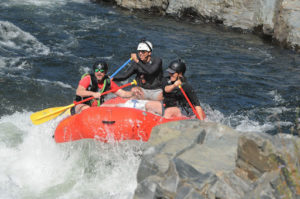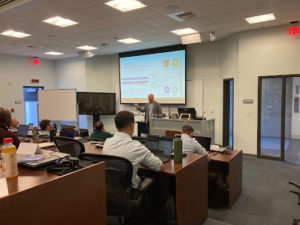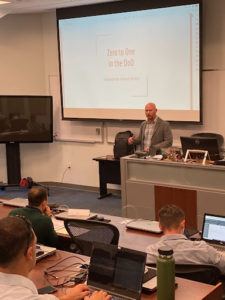The Department of Defense needs an innovation education overhaul.
The Fiscal Year 2021 Annual Report from the Defense Innovation Unit notes: “[w]e live in an era in which technology competition is the new global battleground. Our adversaries are investing heavily, acting nimbly, and building strategically. Therefore, speed in technology adoption and integration is critical.”
Despite this urgent and critical warning, the Defense Innovation Board’s recommendations to establish innovation training and education programs still goes largely unheeded. This quote from Recommendation 16, published in January 2019, states the case nicely:
Department of Defense leaders are not receiving the type or level of education necessary to successfully identify, adopt, and integrate the latest technologies and innovative practices to maintain pace with our adversaries. Successful innovation practices being implemented within the private sector are not understood or are not viewed as acceptable [pathways for the Department of Defense]. As a result, the Department is … straining to adapt to emerging technologies that are changing the character of warfare and is failing to adapt its workforce and processes to address emerging and future challenges.
Two years later the National Security Commission on Artificial Intelligence underscored the Defense Innovation Board recommendation in their behemoth 2021 Final Report. Their 46-page Blueprint for Action titled Foundations of Future Defense contains strong and detailed recommendations to incorporate emerging technologies and innovative development practices, particularly problem curation, into Professional Military Education (PME).
As I stated, the Department of Defense needs an innovation education overhaul.
 Recently traveled to San Francisco and the greater Bay Area, where I met with dual-use investors in the global epicenter of venture capital and entrepreneurship. I also paddled for 20 miles down the American River, over countless rapids and past Sutter’s Mill, California’s original 19th Century venture capital and entrepreneurship hub. But the highlight (and original purpose) of the trip was a visit to the Naval Postgraduate School in Monterey to deliver a guest lecture at their Applied Design for Innovation (AD4I) program. AD4I is an 18-month, Masters of Science degree-conferring program which also satisfies the mid-career officer PME requirement. This truly unique course, conceived by Leo Blanken and directed by Nick Dew, teaches 30-40 officers from the Special Operations community design thinking and lean methodology to enable graduates to rapidly develop and operationalize innovative solutions to meet emergent Special Operations Forces capability needs. Last month I contributed instruction to a similar program at Air
Recently traveled to San Francisco and the greater Bay Area, where I met with dual-use investors in the global epicenter of venture capital and entrepreneurship. I also paddled for 20 miles down the American River, over countless rapids and past Sutter’s Mill, California’s original 19th Century venture capital and entrepreneurship hub. But the highlight (and original purpose) of the trip was a visit to the Naval Postgraduate School in Monterey to deliver a guest lecture at their Applied Design for Innovation (AD4I) program. AD4I is an 18-month, Masters of Science degree-conferring program which also satisfies the mid-career officer PME requirement. This truly unique course, conceived by Leo Blanken and directed by Nick Dew, teaches 30-40 officers from the Special Operations community design thinking and lean methodology to enable graduates to rapidly develop and operationalize innovative solutions to meet emergent Special Operations Forces capability needs. Last month I contributed instruction to a similar program at Air  University. Developed and directed by Bill DeMarco at the Air University Innovation Accelerator (AUiX), the Innovation Research Task Force (iRTF) is an innovation capstone that can be taken as an elective in either Air Command and Staff or Air War College, or as an add-on to a Project Mercury workshop or Blue Horizons Fellowship.
University. Developed and directed by Bill DeMarco at the Air University Innovation Accelerator (AUiX), the Innovation Research Task Force (iRTF) is an innovation capstone that can be taken as an elective in either Air Command and Staff or Air War College, or as an add-on to a Project Mercury workshop or Blue Horizons Fellowship.
In these two programs, students are taught the basic building blocks of innovation, drawing from innovation doctrines such as lean startup, agile product development, Hacking For Defense, and Jeff DeGraff’s iGenome. Students identify a capability gap from their recent and relevant operational experience and effectively act as their own customer for problem curation and MVP development. The students’ capstone project deliverable combines elements of a detailed and validated use case, such as what might come out of a well-executed Phase-1 SBIR, with a dual-track commercialization strategy, describing how the solution could be transitioned within the DoD or transferred and scaled to a commercial market.
 For both programs, I bring to the cohorts practical instruction in use-case development, prototyping, testing, and transition based on experience advising hundreds of dual-use startups. To make the innovation capstone truly “applied,” we also inject real technologies from our broad and dual-use seasoned portfolio of emerging technology startups. Blending in relevant technology and experienced entrepreneurs helps the students develop a tangible and feasible use case, both grounded in technological reality and accounting for product development and go-to-market factors. In addition to creating innovators, these students – typically considered a lost human capital asset while in school – are creating innovations, their coursework spinning out funded projects such as Project Re:fuel.
For both programs, I bring to the cohorts practical instruction in use-case development, prototyping, testing, and transition based on experience advising hundreds of dual-use startups. To make the innovation capstone truly “applied,” we also inject real technologies from our broad and dual-use seasoned portfolio of emerging technology startups. Blending in relevant technology and experienced entrepreneurs helps the students develop a tangible and feasible use case, both grounded in technological reality and accounting for product development and go-to-market factors. In addition to creating innovators, these students – typically considered a lost human capital asset while in school – are creating innovations, their coursework spinning out funded projects such as Project Re:fuel.
AD4I and iRTF are directly addressing the Defense Innovation Board and National Security Commission on Artificial Intelligence recommendations. Yet still, the Department of Defense needs an innovation education overhaul. To get it, the department should treat these cutting-edge pilot programs at NPS and AUiX like they are Phase-2 research and development efforts that are tested, proven, and ready to scale. They should document and share those findings with educational institutions across the department. And they should explore ways to replicate and scale these programs, expanding on the capstone and workshop model, and developing software tools to bring practical innovation practices to the total force. The desired end state should be a true innovation capability integrated into the profession of arms, yielding a force that is capable of using the tools delivered by the National Security Innovation Base.
But it’s not just the uniformed, operating force that needs an innovation education overhaul. The procurement community needs adapted technology development and business models to connect the Defense Innovation System and the Defense Acquisition System. Iterating, testing, and proving these transition pathways will be how we generate the necessary pull from the acquisition community to drive innovation adoption.
Innovation PME allows officers and noncommissioned officers to develop practical skills in a controlled educational environment, seeding a culture change while delivering – albeit currently at very low quantities – real solutions back to the operating force. The same model can be applied to force generating organizations, the target student populations including servicemembers and civilian employees from the acquisition community and defense innovation cells, and their industry counterparts who comprise the other half of the materiel enterprise. Those professionals should understand why we need a Defense Innovation System, how it works, and how it integrates with the Defense Acquisition System.
We at Grayline have ideas and business models to fill these gaps, based on experience advising hundreds of technology startups and small businesses, as well as enterprise and government organizations. As former Army officers, we also know that ideas are great, but execution is better. Action is coming.
To be alerted on our progress, please sign up for updates:



